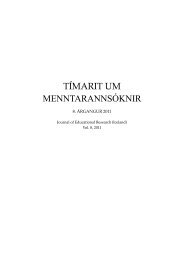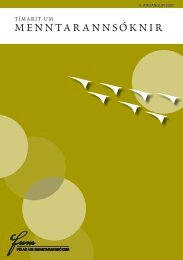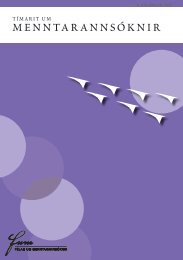Rósa Guðbjartsdóttir og Hanna Ragnarsdóttir. Kennarar og ...
Rósa Guðbjartsdóttir og Hanna Ragnarsdóttir. Kennarar og ...
Rósa Guðbjartsdóttir og Hanna Ragnarsdóttir. Kennarar og ...
Create successful ePaper yourself
Turn your PDF publications into a flip-book with our unique Google optimized e-Paper software.
Tímarit um menntarannsóknir_Layout 1 1/17/11 5:18 PM Page 89<br />
<strong>Kennarar</strong> <strong>og</strong> kennarastarf í fjölmenningarlegu samfélagi<br />
89<br />
slíkar umræður geta stuðlað að auknum þætti<br />
fjölmenningar í skipulagi skólastarfs.<br />
niðurstöður rannsóknarinnar leiddu meðal<br />
annars í ljós að kennsla innflytjendabarna var<br />
með svipuðum hætti, þótt skipulag hennar væri<br />
mislangt á veg komið í þátttökuskólunum.<br />
einnig kom fram að faglegur undirbúningur<br />
kennara væri nauðsynlegur fyrir kennslu inn -<br />
flytjendabarna, sérstaklega vegna þess að<br />
íslensku kennslan væri öðruvísi með erlendum<br />
nemendum. Við getum tekið undir það <strong>og</strong> teljum<br />
að með faglegum undirbúningi verði kennslan<br />
bæði skemmtilegri <strong>og</strong> auðveldari. niðurstöður<br />
sýna einnig að námsver koma að miklu gagni<br />
meðan nemendur af erlendum uppruna eru að<br />
aðlagast íslensku skólaumhverfi, einkum hjálpa<br />
þau þeim að auka hæfni sína í verkefnavinnu<br />
inni í bekkjarstofunni. Þá er ljóst að foreldrar<br />
barna af erlendum uppruna þyrftu að fá tækifæri<br />
til að kynnast betur íslenskri skólamenningu.<br />
með þetta í huga teljum við að kennsla<br />
innflytjendabarna <strong>og</strong> viðhorf kennara til hennar<br />
þurfi að fá meiri athygli. einnig teljum við<br />
mikilvægt að styrkja þátt fjölmenningar í<br />
skipulagi skólastarfs, einkum með því að styðja<br />
kennara með ráðgjöf, námskeiðum eða með<br />
öðrum hætti. að okkar mati styðja kennarar<br />
erlenda nemendur vel með því að nota hópa -<br />
vinnu því að með aðstoð bekkjarfélaganna er<br />
auðveldara fyrir þá að tileinka sér það sem fram<br />
fer í kennslustofunni. Það ætti líka að styrkja<br />
þá í að aðlagast íslenskri skólamenningu.<br />
abstract<br />
Teachers’ experiences in teaching immigrant<br />
students<br />
The main focus of this study was teaching<br />
diverse student groups, in particular teachers’<br />
views towards teaching immigrant students. The<br />
four participating schools had students aged 6<br />
to 16 and all of them emphasized multicultural<br />
learning and teaching. One of the four schools<br />
had formed a clear policy on multicultural<br />
education, but the others had it on their agenda<br />
during the time of the study.<br />
Method<br />
The study was based on qualitative methods<br />
where collection and analysis of data consisted<br />
of interviews with eight compulsory school<br />
teachers about their experiences in teaching<br />
immigrant students. The participants were all<br />
women of different ages and all had had various<br />
experiences working as teachers. The main aim<br />
was to identify some elements that might affect<br />
teachers’ points of view when offering learning<br />
conditions, learning experiences and materials<br />
to diverse groups of students, especially when<br />
immigrant children are part of the group.<br />
Findings<br />
some of the participants emphasised that teach ers<br />
should embrace positive attitudes towards<br />
multicultural teaching. The participants’ motivat -<br />
ions were, among other things, immigrant<br />
students’ increased confidence and joy when they<br />
began to understand more and more. But the main<br />
con straints seemed to be not enough time to find<br />
or develop suitable assignments for children of<br />
diverse origins. some of the things they claimed<br />
counted in providing a multicultural environment<br />
and learning conditions were suitable sizes of<br />
schools, administrators’ readi ness to change, good<br />
school culture, and teachers who show interest or<br />
are devoted to multicultural policy. Participants<br />
also thought that professional preparation was<br />
important since teaching immigrant students is<br />
inevitably quite different from teaching main -<br />
stream groups. some of them thought that the<br />
work was stressful, challenging and that it<br />
included a great deal of work and patience.<br />
The participants also agreed on the rele vance<br />
of a learning centre for immigrant children as a<br />
support for new icelanders when adjusting to<br />
their new environment. They also thought that<br />
immigrant children seemed to have friends<br />
among icelandic children in their schools, but<br />
they did not seem to mingle much with them<br />
after school. The participants also noticed that<br />
cultural differences were prominent when it came<br />
to interaction between icelandic and immigrant<br />
children with respect to their roles and duties at<br />
home. Participants said they interacted with<br />
icelandic parents through email but with<br />
immigrant parents directly with assistance from<br />
an interpreter. They agreed that the immigrant<br />
parents should be given opportunities to get more<br />
acquainted with the icelandic school culture.<br />
Discussion<br />
Tímarit um menntarannsóknir, 7. árgangur 2010






